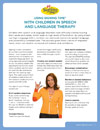Children with Apraxia of Speech experience difficulties when the muscles involved in forming the sounds do not work properly. This makes it hard to say their words. Children with Apraxia and other speech and language disorders have difficulty communicating their wants and needs, which leads to high levels of frustration. By using American Sign Language (ASL), children can overcome barriers to spoken language and successfully communicate. This success gives them a sense of empowerment, which can lead to increased self-esteem and confidence.
As a pediatric SLP, I always knew that I wanted my kids to learn simple signs and have access to communication at a young age. Little did I know when Dylan was a few months old that he would struggle with communication and later be diagnosed with Childhood Apraxia of Speech. Those simple signs we taught him were – and are – critical as he is learning to find his voice. Now any time someone goes near the TV, his little sister signs “BABY BABY BABY” with a hopeful expression because she always wants to watch Baby Signing Time! – Kara, C. Beach House Apraxia
On September 1, 2016 Matthew Solovey published an article on Penn State News titled Sign language may be helpful for children with rare speech disorder which states, “HERSHEY, Pa. — Using sign language with intensive speech therapy may be an effective treatment for children with a rare speech disorder called apraxia of speech, according to Penn State College of Medicine researchers. They suggest further exploration of the results of a case study showing the effectiveness of using several therapies together in cases of early diagnosis.”
It goes on to state, “We suspect that early introduction of sign language by the family proved to be a highly effective form of language development that, when used with sound therapy and therapy to improve the functioning of the mouth muscles, helped correct speech issues quickly,” Tierney said. “More research is needed to determine how much the use of sign language contributed to such rapid correction of apraxia of speech. However, our case highlighted that when we combined early detection, early treatment and the use of sign language we had an optimal outcome which suggests an area of further study.”
Two of our Signing Time Academy Instructors who are Speech Language Pathologists (SLP) wrote Using Signing Time® with Children in Speech and Language Therapy guide to assist parents, teachers and other SLPs with using Sign Language to support children with Apraxia and other speech and language disorders. In the guide it states, “The use of ASL as a functional communication strategy has grown in popularity in recent years because both parents and professionals appreciate the convenience it affords. With signs, there is no communication device or book to tote, no charging or replacing batteries, no forgetting it at home. Your hands are always with you! In addition to providing a convenient form of functional communication, signing helps children with speech and language disorders improve both their receptive and expressive language skills.”

Click here to request a free 10 page guide.
With signs, children can overcome barriers to spoken language and successfully communicate. This success gives them a sense of empowerment, which can lead to increased self-esteem and confidence. Using Signing Time® with Children in Speech and Language Therapy
Find an Instructor in your area
If you can’t find an Instructor near you, some of our Instructors are doing classes and consults via Skype and Google Hangout. Visit our Academy Facebook Page if you need an online Instructor and we can get you in contact with one.

